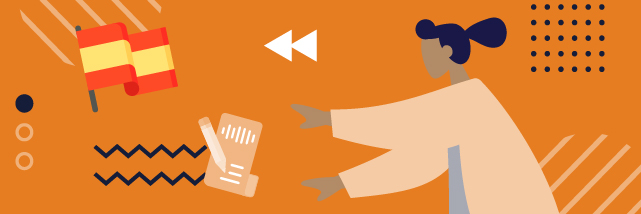8% of all internet traffic is in Spanish. What’s more, nearly all of the total activity on the web is video streaming. In addition to that, transcribed videos have, on average, 13% more views. In case I need to spell it out: Spanish transcription is not an if, but an absolute must. If you want to engage the Spanish-speaking market and gain a lot from putting in comparatively little, read on.
And video marketing is not the only place where you could use Spanish transcription pros. Transcriptions and captions don’t just generate more engagement, they open up viewing possibilities for those with disabilities as well; many Spanish-speaking people are hearing impaired and need captions in order to view content. So, a great transcription fosters more inclusivity. grows your overall market, and increases total viewership numbers. Not bad, if you ask me.
But, quirky asides regardless, let’s get to the meat of this article. Today, you’ll learn:
- What a great transcription can do for you and your video marketing efforts.
- Additional benefits of transcriptions.
- Why and where to get great transcription pros.
What is Spanish Transcription?
First, allow me to give you a quick tour of the transcription world. While transcriptions, subtitles, and captions are closely related, and part of the same family, they’re not the same. In one of our Bunny Library articles about transcription, Ignacio S. gives us a perfect definition:
Transcription is the process of converting speech or audio into a written text. It is used when it is necessary to convert audio-only programs on radio or podcasts for people who perhaps are deaf, for example.
(…) There are two main types of transcription too: verbatim and clean-read transcriptions. Verbatim basically means transcribing a text word by word. This includes, naturally, all that a speaker is saying, including words such as “um”, mistakes, slang words which are not easily understandable by a listener etc. A clean-read, on the other hand, is a transcription that excludes these errors and fillers.
So, Spanish transcription is the process of converting Spanish-language speech into text. Moreover, a great transcription is often the first part of closed captions. What’s the difference? Closed captions offer additional information aimed at folks with hearing disabilities. Part of the captioner’s job is to explain things like sounds and music through text. And this is not just limited to people with disabilities; most people watch social media videos on mute, for example. But more on that below.
Who Does Spanish Transcription, Exactly?
They can be handled in-house, or by a professional transcriber. This process is typically time-consuming and requires plenty of attention to detail. Especially when it comes to things like interview transcriptions, or legal transcriptions, authenticity is the name of the game. That means that paying attention to speech quirks, pauses, “umms,” and “aahs” is especially important. In these cases, there is no room for interpretation; the transcriber has to write everything down word-by-word.
There’s also the matter of text-to-speech programs. While we’ve made plenty of advances with these, they’re not quite there yet. So, in a best-case scenario, they can jumpstart a transcription effort, but they’re not good enough to go the whole nine yards. That means that the transcriber will certainly need to listen intently and carefully. Or else? Well, just turn on automatic captions on YouTube for a video without human-made subtitles and see for yourself. The horror. The horror.
Is there a Professional Certification?
No, but transcription often collides with other professional disciplines. Subtitlers and captioners often need to be good translators and writers, for example. And, while there’s no need for professional certification, most agencies and employers will want multi-skilled transcribers. After all, you get more out of a talented jack-of-all-trades than a one-trick pony, right? Just a matter of common sense.
Still, there are things that should be common for any transcriber:
- Above-average spelling and grammar skills. And this goes beyond just regular, on-the-fly stuff. After all, transcribers will need to proofread their work, which often means researching difficult words and specific jargon. Ahem, I meant “terminology” there.
- A laser-beam focus. Of course, some transcribers work with video and podcasts, so they can go back. But what about those who need to do their transcriptions live? They need to be locked in tight like a homing missile.
- The right tools for the job are also important. A great transcriber can’t be completely technologically illiterate, for instance. Beyond having good knowledge of word processors, a decent keyboard, and a great headset, they need to be proficient at using these tools of the trade together in a competent way.

Some of the Benefits of Transcription
Now, beyond the in-person transcription trade, there’s plenty to gain from online transcription efforts. As I said at the beginning of the article, most of the internet’s traffic is video. You can bet that the Spanish-speaking audience is no exception to this. Spanish transcription can provide a plethora of benefits to your video marketing strategy, whether it’s on social media or elsewhere. How so? Mostly through the magic of SEO, or Search Engine Optimization.
We all look for different terms on Google several times a day. Even the Luddites among us can’t seem to break away from the grasp of the big G. The thing is, transcriptions increase the chances for users to find you on the first page instead of, say page 13, where no one but the most relentless info diggers dare enter. What kind of wizardry is this? Read on.
A Full-Text Transcript Will Increase Your Overall Traffic
And this is whether your audience reads it or not! Regardless of whether you’re hosting a hit podcast or creating videos for your brand, a text transcript is a big help. You see, Google indexes video and text separately. Regardless of the advances in technology, Google doesn’t create auto-transcripts for videos. That’s up to humans — at least for the time being. So, creating a transcript is an additional form of telling a search engine’s algorithm that your site has value. The result? Boom: you appear higher on searches, just like that, leading to increased traffic.
A media site pitches in on the matter:
Search engines can’t watch a video or listen to audio, but they do index text. A transcript enables search engines to ingest your multimedia content and index it accordingly.
Consider the SEO structure of a news article. It has a title, byline, and body of text — all of which get indexed by Google. A video has a title and maybe a description, but the content remains invisible to search bots.
And, by the way, your content doesn’t even necessarily have to be originally in Spanish. A little tip: multi-language transcripts/captions are indexed separately. The more you have, the better your SEO score, so it’s not “just” a Spanish transcript. You’re welcome.
Make More Moolah
Yeah, I like alliteration. You know what I like even more? Making bank, and that’s what you’ll be doing with a Spanish transcript as part of your SEO strategy. Sites with transcribed audio make, on average, sixteen percent more than those that don’t. Make of that what you will, but I’d call it an incentive.
Up We Go!
If you use Spanish transcripts, you’ll end up ranking higher on search results. That means a net increase in traffic, views, engagement, and popularity! I mean, transcriptions won’t make you one of the cool kids, but they’re much appreciated nonetheless.
It Makes People Want to Watch Your Videos More
Ever spent a lazy afternoon scrolling through social media? You and me both! But if there’s something that we don’t do often is unmute those pesky videos that appear on our feed, unless they’re really, really interested. Whether you’re making content for YouTube, Facebook, Instagram, or another social media platform, people tend to appreciate captions. Why? Because over 85% of us watch those videos on mute and decide whether we want to listen to them after reading the captions for a bit.
Not only that, but there’s the aforementioned benefit for hard-of-hearing folk, and those who can’t unmute videos do to, say, being on the bus. On average, transcribed/captioned videos tend to get an increase in views around 8%. Facebook did their own research on the matter, and they found a whopping 12% increase! I don’t want to put ideas into your head, but maybe you should get crackin’!
Off-Page SEO
SEO works by targeting keywords, or popular search terms. Spanish transcription helps you target those terms with a higher focus. If you’re looking to engage the Spanish-speaking market, it goes without saying that you’re going to need them to find you with terms that actually make sense for your brand and intended viewership. Video and podcast transcripts can help with this big time, and they work even if no one is looking at them! Such is the magic of the Indexing Gods.
In Sum
Spanish transcripts are a great way to generate more online buzz, improve SEO, and engage a much wider, diverse audience. If you’re looking to improve your marketing strategy on the cheap, then transcription is a bare-bones necessity, part of the grassroots effort needed to get an edge in today’s competitive market.
And, if you want transcripts, you want ’em done right. At Bunny Studio, we’ve assembled an awesome team of hyper-capable pros ready to tackle your every transcription project, big or small. Whether it’s word-for-word transcripts, translations, subtitling, closed captions, or anything above and beyond, we’re ready to deliver amazing results with the best turnaround time in the business.
So, if you need pros who bring their A-game to the table every single time, drop us a line or two. We’d love to work on your project!










